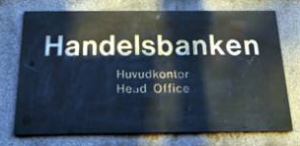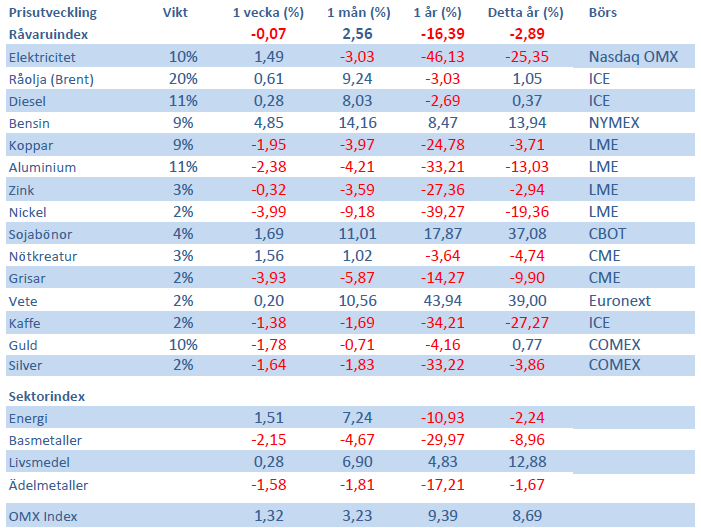Analys
SHB Råvarukommentar 3 augusti 2012
 Centralbankerna i fokus
Centralbankerna i fokus
Veckans agenda var tung både på datafronten och för centralbanker. För en gång skull var Fed bara en aperitif till ECB. Bernanke & Co presenterade egentligen inga nyheter och marknaden blev lätt besviken. Emellertid höjde Fed beredskapen ett snäpp och indikerar att ytterligare stimulanser kan bli aktuella redan i september om data så motiverar. Nästa nyckeldatum är den 31 augusti då Bernanke drar ut riktlinjerna i Jackson Hole.
Förväntningarna var högt ställda på ECB:s penningpolitiska möte efter Draghis kraftiga signalering veckan innan. Medan ECB indikerade att de jobbar på att hjälpa hårt ansatta sydeuropeiska obligationsmarknader blev marknaden besviken över att alltför lite var konkret. Dessutom var oenigheten inom ECB tydligare än någonsin vilket knappast får marknaden att känna sig trygg.
Medan oron för den europeiska ekonomin har varit utbredd under längre tid har rädslan för att eurokrisens effekter sprider sig till USA stigit. ISM för tillverkningsindustrin låg oväntat kvar under det känsliga 50-strecket i juli. Sysselsättningen i juli accelererade dock i juni och gav marknaden hopp om framtiden. Den senaste magra dataskörden är dock inte oväntad givet vårens negativa impuls från finansiella marknader till realekonomin. Den finansiella stabiliseringen under sommaren bör motverka fortsatt försämring av makrodata framöver.
Kan uppgången fortsätta för råvaror?
Vi har sedan den 19 juni varit positiva till råvaror och SHB råvaruindex har sedan dess letat sig allt högre. Frågan som infinner sig nu är om råvarupriserna kan fortsätta att stiga. Vi anser att så är fallet, och att den uppgång vi sett senaste tiden kommer att fortsätta. Framför allt tror vi att energi – drivet av oljepriset – har mycket kvar att ge, även om basmetallerna gjort oss besvikna under sommaren. Nyckeln för basmetallpriserna är naturligtvis utvecklingen i Kina, och huruvida Kina fortsätter att försöka stimulera sin ekonomi (räntorna har sänkts i både juni och juli). När det gäller ädelmetaller så fortsätter dessa att handla som basmetaller, och vi ser ingen anledning i närtid till att detta mönster ska upphöra.
Spannmålspriserna fortsätter att vara väldigt volatila, och vädersituationen är alltjämt osäker. Ryssland är numera medlemmar i WTO, men kan införa exportrestriktioner på samma sätt de gjort historiskt om deras spannmålssituation inte förbättras. Det är därför svårt i dagsläget att säga att vi sett toppen på spannmålspriserna, risken är stor att de fortsätter upp under hög volatilitet.
Totalt sett ser vi fortsatt bra möjligheter till stigande råvarupriser även framöver, framförallt drivet av oljepriset som kommer att fortsätta stiga i denna miljö med stimulerande centralbanker och återfunnen riskaptit. Dagens marknadsreaktioner gör att vi bjuds in till något lägre priser!
Fördjupning – Jordbruksprodukter
Vete
Terminspriser på vete har i veckan gått ned i Chicago men noteras i stort sett oförändrade i Paris. Bättre väder för det amerikanska vårvetet har gett viss press nedåt på priserna och skörden kan fortsätta utan avbrott. Ytterligare lite press nedåt har kommit från höjda prognoser för den kanadensiska skörden. Däremot har regnet kommit tillbaka i delar av Europa, bland annat i Tyskland, norra Frankrike och i Storbritannien vilket fördröjer skörden något. Lite regn uppges falla i de torra delarna av Australien men oron är långt ifrån borta, även i Argentina behövs mer regn. Vetesådden i Argentina uppges vara till 94 procent avklarad, ungefär i nivå med motsvarande siffra förra året men i år är arealen cirka 22 procent mindre.
Efterfrågan har tilltagit den senaste tiden, inte minst på ryskt vete och som vanligt spekuleras det om eventuellt införande av någon form av exportrestriktioner – vilket blir allt mer sannolikt då produktionsnivån hela tiden justeras ned. Någon större prisnedgång är svår att se inom snar framtid, på lite längre sikt är risken dock som vanligt stor och fallhöjden är såklart väldigt stor från dagens nivåer.
Majs
Majsen i Chicago har gått ned något i pris under veckan påverkat främst av viss vinsthemtagning efter en lång tid med stigande priser. Avkastningspotentialen fortsätter dock att försämras i USA och det varma och torra vädret ser ut att bestå åtminstone 10-15 dagar till, en del prognoser pekar på att rådande väderlek kommer finnas kvar långt längre fram i tid än så. Även i EU:s majsområden och inte minst i Ukraina är det torrt och varmt, vilket påverkar produktionsnivån klart negativt. Efterfrågan är fortsatt avtagande, inte minst från etanolindustrin, men avkastningspotentialen verkar fortfarande minska än mer. Trots alla negativa nyheter verkar majsen ha svårt att stiga så mycket mer i pris, marknaden är lite avvaktande inför nästa veckas WASDE-rapport från det amerikanska jordbruksdepartementet och till dess får vi nog räkna med ganska volatila priser.
Sojabönor
Sojapriserna i Chicago har gått ned något i pris under den gångna veckan, en del prognoser pekar på att viss nederbörd kan falla i kommande dagar. Regn kan få avkastningsnivån att stabilisera sig något men någon större förbättring väntas inte – det handlar nog mest om att nedgången i avkastningspotential avtar. Likt för majsen verkar marknaden vara lite avvaktande inför nästa veckas rapport från USDA, trots nedjusteringar från flera amerikanska analytiker vill marknaden ha ytterligare bekräftelse. Prognoser innehåller förväntade avkastningssiffror inom intervallet 33-38 bushels per acre, att jämföra med 40,5 bushels per acre i juli månads WASDE-rapport. Nedsidan bör vara klart begränsad men förvänta er volatila priser innan fredagens rapport.
Handelsbankens Råvaruindex

Handelsbankens råvaruindex består av de underliggande indexen för respektive råvara. Vikterna är bestämda till hälften från värdet av global produktion och till hälften från likviditeten i terminskontrakten.
[box]SHB Råvarubrevet är producerat av Handelsbanken och publiceras i samarbete och med tillstånd på Råvarumarknaden.se[/box]
Ansvarsbegränsning
Detta material är producerat av Svenska Handelsbanken AB (publ) i fortsättningen kallad Handelsbanken. De som arbetar med innehållet är inte analytiker och materialet är inte oberoende investeringsanalys. Innehållet är uteslutande avsett för kunder i Sverige. Syftet är att ge en allmän information till Handelsbankens kunder och utgör inte ett personligt investeringsråd eller en personlig rekommendation. Informationen ska inte ensamt utgöra underlag för investeringsbeslut. Kunder bör inhämta råd från sina rådgivare och basera sina investeringsbeslut utifrån egen erfarenhet.
Informationen i materialet kan ändras och också avvika från de åsikter som uttrycks i oberoende investeringsanalyser från Handelsbanken. Informationen grundar sig på allmänt tillgänglig information och är hämtad från källor som bedöms som tillförlitliga, men riktigheten kan inte garanteras och informationen kan vara ofullständig eller nedkortad. Ingen del av förslaget får reproduceras eller distribueras till någon annan person utan att Handelsbanken dessförinnan lämnat sitt skriftliga medgivande. Handelsbanken ansvarar inte för att materialet används på ett sätt som strider mot förbudet mot vidarebefordran eller offentliggörs i strid med bankens regler.
Analys
Volatile but going nowhere. Brent crude circles USD 66 as market weighs surplus vs risk

Brent crude is essentially flat on the week, but after a volatile ride. Prices started Monday near USD 65.5/bl, climbed steadily to a mid-week high of USD 67.8/bl on Wednesday evening, before falling sharply – losing about USD 2/bl during Thursday’s session.

Brent is currently trading around USD 65.8/bl, right back where it began. The volatility reflects the market’s ongoing struggle to balance growing surplus risks against persistent geopolitical uncertainty and resilient refined product margins. Thursday’s slide snapped a three-day rally and came largely in response to a string of bearish signals, most notably from the IEA’s updated short-term outlook.
The IEA now projects record global oversupply in 2026, reinforcing concerns flagged earlier by the U.S. EIA, which already sees inventories building this quarter. The forecast comes just days after OPEC+ confirmed it will continue returning idle barrels to the market in October – albeit at a slower pace of +137,000 bl/d. While modest, the move underscores a steady push to reclaim market share and adds to supply-side pressure into year-end.
Thursday’s price drop also followed geopolitical incidences: Israeli airstrikes reportedly targeted Hamas leadership in Doha, while Russian drones crossed into Polish airspace – events that initially sent crude higher as traders covered short positions.
Yet, sentiment remains broadly cautious. Strong refining margins and low inventories at key pricing hubs like Europe continue to support the downside. Chinese stockpiling of discounted Russian barrels and tightness in refined product markets – especially diesel – are also lending support.
On the demand side, the IEA revised up its 2025 global demand growth forecast by 60,000 bl/d to 740,000 bl/d YoY, while leaving 2026 unchanged at 698,000 bl/d. Interestingly, the agency also signaled that its next long-term report could show global oil demand rising through 2050.
Meanwhile, OPEC offered a contrasting view in its latest Monthly Oil Market Report, maintaining expectations for a supply deficit both this year and next, even as its members raise output. The group kept its demand growth estimates for 2025 and 2026 unchanged at 1.29 million bl/d and 1.38 million bl/d, respectively.
We continue to watch whether the bearish supply outlook will outweigh geopolitical risk, and if Brent can continue to find support above USD 65/bl – a level increasingly seen as a soft floor for OPEC+ policy.
Analys
Waiting for the surplus while we worry about Israel and Qatar

Brent crude makes some gains as Israel’s attack on Hamas in Qatar rattles markets. Brent crude spiked to a high of USD 67.38/b yesterday as Israel made a strike on Hamas in Qatar. But it wasn’t able to hold on to that level and only closed up 0.6% in the end at USD 66.39/b. This morning it is starting on the up with a gain of 0.9% at USD 67/b. Still rattled by Israel’s attack on Hamas in Qatar yesterday. Brent is getting some help on the margin this morning with Asian equities higher and copper gaining half a percent. But the dark cloud of surplus ahead is nonetheless hanging over the market with Brent trading two dollar lower than last Tuesday.

Geopolitical risk premiums in oil rarely lasts long unless actual supply disruption kicks in. While Israel’s attack on Hamas in Qatar is shocking, the geopolitical risk lifting crude oil yesterday and this morning is unlikely to last very long as such geopolitical risk premiums usually do not last long unless real disruption kicks in.
US API data yesterday indicated a US crude and product stock build last week of 3.1 mb. The US API last evening released partial US oil inventory data indicating that US crude stocks rose 1.3 mb and middle distillates rose 1.5 mb while gasoline rose 0.3 mb. In total a bit more than 3 mb increase. US crude and product stocks usually rise around 1 mb per week this time of year. So US commercial crude and product stock rose 2 mb over the past week adjusted for the seasonal norm. Official and complete data are due today at 16:30.
A 2 mb/week seasonally adj. US stock build implies a 1 – 1.4 mb/d global surplus if it is persistent. Assume that if the global oil market is running a surplus then some 20% to 30% of that surplus ends up in US commercial inventories. A 2 mb seasonally adjusted inventory build equals 286 kb/d. Divide by 0.2 to 0.3 and we get an implied global surplus of 950 kb/d to 1430 kb/d. A 2 mb/week seasonally adjusted build in US oil inventories is close to noise unless it is a persistent pattern every week.
US IEA STEO oil report: Robust surplus ahead and Brent averaging USD 51/b in 2026. The US EIA yesterday released its monthly STEO oil report. It projected a large and persistent surplus ahead. It estimates a global surplus of 2.2 m/d from September to December this year. A 2.4 mb/d surplus in Q1-26 and an average surplus for 2026 of 1.6 mb/d resulting in an average Brent crude oil price of USD 51/b next year. And that includes an assumption where OPEC crude oil production only averages 27.8 mb/d in 2026 versus 27.0 mb/d in 2024 and 28.6 mb/d in August.
Brent will feel the bear-pressure once US/OECD stocks starts visible build. In the meanwhile the oil market sits waiting for this projected surplus to materialize in US and OECD inventories. Once they visibly starts to build on a consistent basis, then Brent crude will likely quickly lose altitude. And unless some unforeseen supply disruption kicks in, it is bound to happen.
US IEA STEO September report. In total not much different than it was in January

US IEA STEO September report. US crude oil production contracting in 2026, but NGLs still growing. Close to zero net liquids growth in total.

Analys
Brent crude sticks around $66 as OPEC+ begins the ’slow return’

Brent crude touched a low of USD 65.07 per barrel on Friday evening before rebounding sharply by USD 2 to USD 67.04 by mid-day Monday. The rally came despite confirmation from OPEC+ of a measured production increase starting next month. Prices have since eased slightly, down USD 0.6 to around USD 66.50 this morning, as the market evaluates the group’s policy, evolving demand signals, and rising geopolitical tension.

On Sunday, OPEC+ approved a 137,000 barrels-per-day increase in collective output beginning in October – a cautious first step in unwinding the final tranche of 1.66 million barrels per day in voluntary cuts, originally set to remain off the market through end-2026. Further adjustments will depend on ”evolving market conditions.” While the pace is modest – especially relative to prior monthly hikes – the signal is clear: OPEC+ is methodically re-entering the market with a strategic intent to reclaim lost market share, rather than defend high prices.
This shift in tone comes as Saudi Aramco also trimmed its official selling prices for Asian buyers, further reinforcing the group’s tilt toward a volume-over-price strategy. We see this as a clear message: OPEC+ intends to expand market share through steady production increases, and a lower price point – potentially below USD 65/b – may be necessary to stimulate demand and crowd out higher-cost competitors, particularly U.S. shale, where average break-evens remain around WTI USD 50/b.
Despite the policy shift, oil prices have held firm. Brent is still hovering near USD 66.50/b, supported by low U.S. and OECD inventories, where crude and product stocks remain well below seasonal norms, keeping front-month backwardation intact. Also, the low inventory levels at key pricing hubs in Europe and continued stockpiling by Chinese refiners are also lending resilience to prices. Tightness in refined product markets, especially diesel, has further underpinned this.
Geopolitical developments are also injecting a slight risk premium. Over the weekend, Russia launched its most intense air assault on Kyiv since the war began, damaging central government infrastructure. This escalation comes as the EU weighs fresh sanctions on Russian oil trade and financial institutions. Several European leaders are expected in Washington this week to coordinate on Ukraine strategy – and the prospect of tighter restrictions on Russian crude could re-emerge as a price stabilizer.
In Asia, China’s crude oil imports rose to 49.5 million tons in August, up 0.8% YoY. The rise coincides with increased Chinese interest in Russian Urals, offered at a discount during falling Indian demand. Chinese refiners appear to be capitalizing on this arbitrage while avoiding direct exposure to U.S. trade penalties.
Going forward, our attention turns to the data calendar. The EIA’s STEO is due today (Tuesday), followed by the IEA and OPEC monthly oil market reports on Thursday. With a pending supply surplus projected during the fourth quarter and into 2026, markets will dissect these updates for any changes in demand assumptions and non-OPEC supply growth. Stay tuned!
-

 Nyheter4 veckor sedan
Nyheter4 veckor sedanMeta bygger ett AI-datacenter på 5 GW och 2,25 GW gaskraftverk
-

 Nyheter4 veckor sedan
Nyheter4 veckor sedanAker BP gör ett av Norges största oljefynd på ett decennium, stärker resurserna i Yggdrasilområdet
-

 Nyheter4 veckor sedan
Nyheter4 veckor sedanEtt samtal om koppar, kaffe och spannmål
-

 Analys4 veckor sedan
Analys4 veckor sedanBrent sideways on sanctions and peace talks
-

 Nyheter4 veckor sedan
Nyheter4 veckor sedanSommarens torka kan ge högre elpriser i höst
-

 Analys4 veckor sedan
Analys4 veckor sedanBrent edges higher as India–Russia oil trade draws U.S. ire and Powell takes the stage at Jackson Hole
-

 Nyheter3 veckor sedan
Nyheter3 veckor sedanMahvie Minerals är verksamt i guldrikt område i Finland
-

 Analys3 veckor sedan
Analys3 veckor sedanIncreasing risk that OPEC+ will unwind the last 1.65 mb/d of cuts when they meet on 7 September











